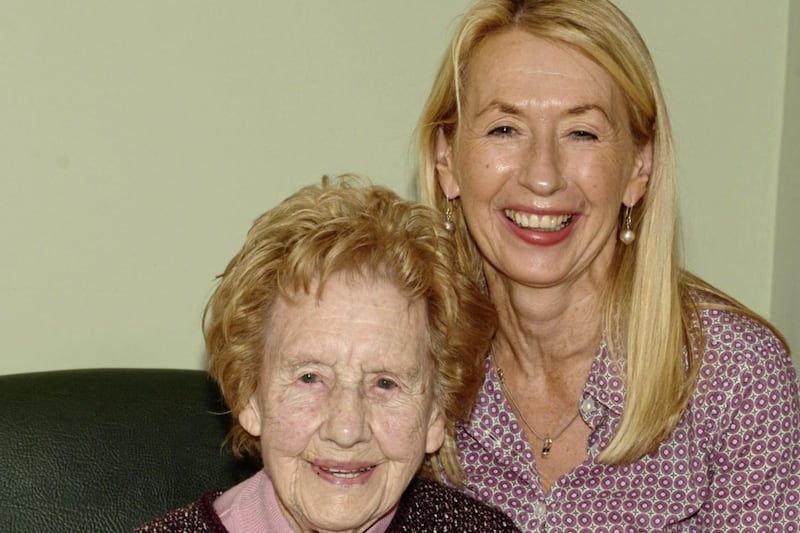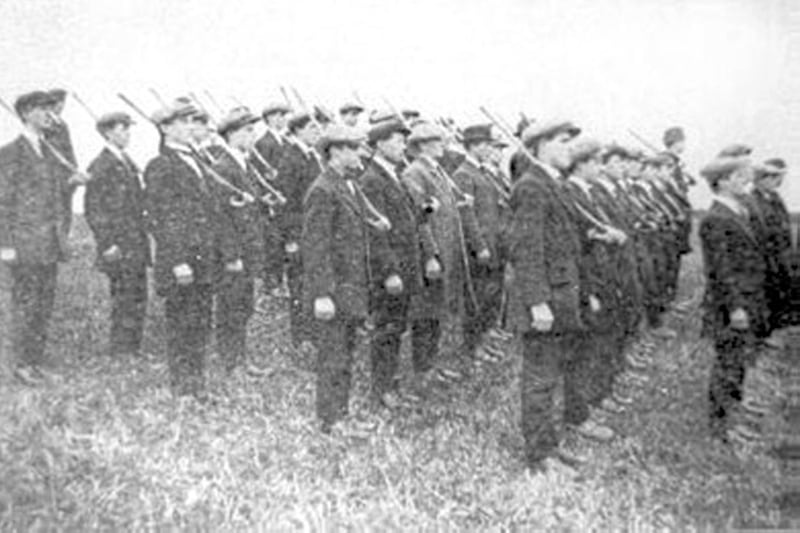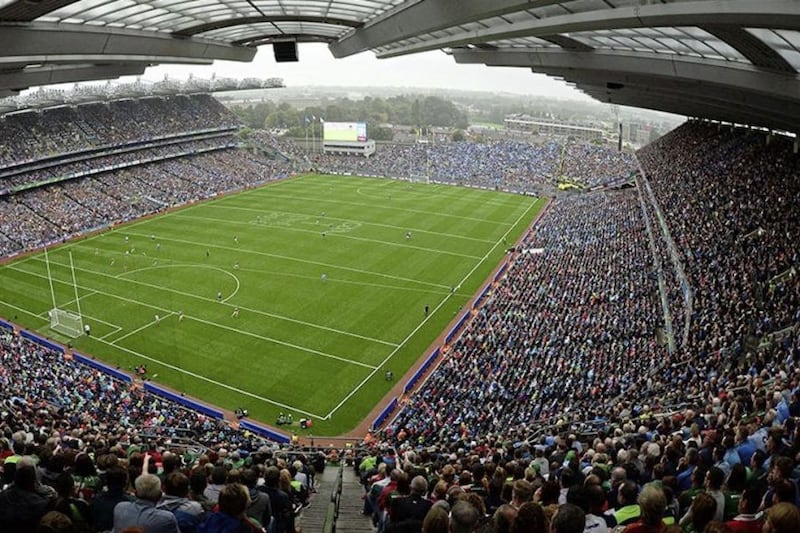‘GAELIC Sunday’ has been portayed as a victory against the might of the British Empire – but was it actually a finish to an unguarded net?
After all the British Government later argued that, in fact, no prohibition of games had been intended and that the ban only applied if a GAA event was used as an occasion of a political speech.
As ever on this island, the truth lies somewhere in between – like the venue of a match that reportedly took place in Fermanagh – or was it Cavan?
Michael McPhillips from Newtownbutler contacted this paper with a brilliant tale and another interesting detail:
“Many of the papers of the day declared that the Gaelic Sunday passed off without incident but in fact the RIC prevented numerous games from taking place throughout the country.
“One famous act of defiance against the new illegal assembly act took place at a rural location at Wattlebridge, four miles south of Newtownbutler, within yards of the Cavan border.
“The local team, Wattlebridge Éire Ógs, made up mainly of members of the local Volunteer Company took to the field take part in a challenge match, led by local captain Matt Fitzpatrick - who would later become prominent in the war of independence in the area.
“A short time into the game a force of RIC arrived from nearby Newtownbutler, stormed the field and halted the game and proceeded to take participants’ names and addresses.
“Not to be out-done local islanders with flat-bottomed boats known locally as ‘cots’ arrived and commenced to take down the goal posts and, with the two teams on board, floated the short distance across the river Finn and set up the goal posts on a meadow on the island of Derrykerrib.
“There they continued to play out the game to the annoyance of the RIC, who had no transport to get them onto the island and, so Wattlebridge had struck a blow for the attempt to suppress their culture and games.”
His other snippets shows that clubs on the ground did not trust the word of the British that Gaelic games could go ahead unhindered: “In Enniskillen ‘Gaelic Sunday’ began early, at 8am, when Enniskillen played Coa in a hurling game.”
Venue TBC...
Another ruse to avoid the attentions of the authorities was planned on the border of counties Tyrone and Derry.
Joe Martin, author of Tyrone’s GAA history, interviewed Joe McAnespie from Cookstown, then aged over 90, in 1983. A member of the Tyrone championship-winning Cookstown Brian Óg team of 1917, Mr McAnespie recalled that that games were organised for the same time on that day at different venues in the Cookstown area - one at Killybearn, one at Drumullan, and one at Moveagh - so that it would not be possible for any ban to be enforced.
He explained that young men who were not regular players gathered at the appointed venues to help make up teams and thus to ensure that the games were played.
Joe McAnespie took part in the game at Moveagh, between Cookstown and the Rock, and although the British did not harass him, another local resident did.
On his return to the cow-shed where he had togged out, he discovered that a calf had tried to make a meal of his good Sunday shirt. “I can laugh at it now”, he said, “but it was not funny at the time”.
Matches prevented
As Mr McPhillips says, the reporting of the events ‘Gaelic Sunday’ wasn’t entirely accurate.
The ‘Freeman’s Journal’ (FMJ) headline declared ‘Fixtures brought off without a hitch’, but although the FMJ said that “there was no interference with the matches, which were carried out with perfect order in the presence of large numbers of spectators” matches WERE prevented from taking place in at least two other venues, but very significant ones: Croke Park and Clones.
The ‘Anglo-Celt’ reported that ‘In common with all parts of Ireland, the Gaels of Clones made preparations for Gaelic Day and advertised a match and sports to take place on the Gaelic grounds.
“At noon four motor lorries and several motor cars brought in forces and police outposts were placed on all roads and on the surrounding hills. From early morning until dark the Gaelic grounds were patrolled, as was also another venue on the workhouse road.
“Sharp to advertised time, on a field kindly given for the occasion, convenient to the main road from Monaghan to Clones, and about a mile from the latter, Mr Owen O’Duffy lined out the teams for the football game. Both sides were drawn from the St Tierney [sic] club and, to distinguish them, one took the name of ‘Kaffers’ and the other ‘Hottentots’. [These name choices seem dubious now, but apparently the derivation was from ethnic groups who had fought against the British in the First Boer War].
“The match, which was witnessed by a large crowd, was keenly contested, and ended in a win for the ‘Kaffers’ by 5 points to 3, but both sides acquitted themselves creditably…
“After the teams had been entertained, a cycling corps was formed and proceeded to the town, through Analore Street, Diamond, and Fermanagh Street, dispersing in Erne Square. About 9 o’clock the military left the town, but just at midnight returned.”
The ‘Celt’ also recorded that “Denn and Lacken club were ordered to explain why they did not field teams on Sunday. One player from Drumbo, one from Kilnaleck, one from Crosserlough, one from Arva, one from Castletara, ordered off on Sunday, were suspended for twelve months. An Annah [sic] player was severely reprimanded.”
Even the GAA factsheet on ‘Gaelic Sunday’ omits the police presence in Clones, stating that “it was only at Croke Park that there was any attempt to prevent matches taking place. As armed police backed up by troops prevented entry to the grounds camogie players treated officers at Croke Park to the spectacle of a game of camogie outside on Jones’s Road.
“An oral tradition has survived in the Fingal area to the effect that Michael Collins and Harry Boland turned up on bicycles at St Margaret’s Ground and took part in a football match.
“Gaelic Sunday even extended to jails and prison camps throughout the British Isles." Indeed it's said that ‘Gaelic Sunday’ was celebrated in Belfast Gaol with an inter-provincial football match where 'Munster' and 'Ulster' combined to play against 'Leinster' and 'Connacht'. The game ended in a diplomatic draw - and watching prisoners letting out a shout of ‘Up Ireland’.
“Gaelic Sunday succeeded beyond all expectations. It has been described as the greatest single act of defiance outside of the purely political sphere between 1916 and 1922,” claims the GAA.
Ulster involvement limited
Yet, although the FMJ claimed that ‘Every town and district had its own venue’, games in Ulster were mostly confined to the south of the province, largely in Cavan (17 matches), Monaghan (27), south Armagh (Crossmaglen and Camlough), and south Down (the Marshes and Hilltown).
There were also games at Maghery and Kilmore in north Armagh, Duke’s Grove in Armagh city (near Pearse Og’s current Ballycrummy Rd grounds), and at Newtownhamilton, and Banbridge in county Down, where Ballyvarley Shamrocks faced John Mitchel’s.
In the cities of Belfast and Derry it would undoubtedly have been difficult to organise matches away from the attention of the authorities, but the GAA was not strong then in the Oak Leaf county anyway, nor in neighbouring Donegal.
“We know the GAA was a little bit slow to spread into the north,” says Prof. David Hassan. The Ulster Council was only formed in 1903, after all.
Hilltown humour
The result of the match played in Hilltown, county Down, was reportedly ‘DORA’ 1-1 ‘Small Nations’ 3-1. The DORA centre-forward, who scored the first goal, was ‘Sir Edward Carson’, described as “a fast mover, with a flair for a dramatic and flamboyant game, with an uncanny knack of always wrong-footing an opponent by a brilliantly executed side-step...” However, the opposition, for whom ‘Peter Rainbow’ got on the scoresheet, fought back to win.
The Clonduff Committee had chosen as referee ‘Jack French’, while his umpires apparently included the Chief Secretary of Ireland, Edward Shortt, and one of his predecessors in that post, Walter Hume Long.
A wag known as `The Shinner’ suggested that these two had been chosen because they never lost sight of their goal, watching their posts – the higher the posts the keener their eyes and the better they watched them.
It was also alleged that “the linesmen were two veteran Home Rulers, well chosen for the side-lines, where they passed their political lives.” The green flags they carried were, supposedly, gifts from a Liberal politician “who wished to keep the Home Rule Party happy with some concessions, such as allowing them to wave the green flag and keep extremists from going too far on one side or the other.”
Clearly this report was satirical [John, Viscount French was the Lord Lieutenant of Ireland, the USA had sent a 'Rainbow Division' to France], but it was probably sensible to record the actual players under pseudonyms; perhaps ‘noms de guerre’ would be a more accurate term.
‘DORA’ stood for ‘Defence of the Realm Act’, which gave the British government wide-ranging powers at the outbreak of war, which the British were supposedly fighting in defence of ‘Small Nations’, such as Serbia and Belgium – but not Ireland.
Humour aside, ‘Gaelic Sunday’ was a huge part of the battle for the future of the Gaelic Athletic Association.
There were no complaints that all the matches across the island of Ireland that day (apart from that reported hurling match in Fermanagh) had exactly the same throw-in time of 3pm.
It has been estimated that more than 1500 hurling, football and camogie matches were played across Ireland: with two teams in each and nominally 15 players per team, that means more than 45,000 athletes took part in ‘Gaelic Sunday’, and the amount of spectators has been calculated at more than 100,000.
A team of priests and a team of Christian Brothers competed in a hurling match in Kilkee, Co. Clare. In Athlone, two RIC officers and a ‘large number of soldiers’ were present at a game, but only as paying spectators rather than in any official capacity.
In Kilruane, Co. Tipperary, a police sergeant and constable tried to get into a game but were told that only paying spectators were allowed within the grounds - so they watched from the street.
In Dublin, 14 boys, aged between 12 and 17, were taken into police custody for selling flags on the street; their names and addresses were taken down but they were allowed to go home without charge.
Debate over GAA's revolutionary influence
David Hassan, Professor of Sport Policy and Management at Ulster University, who researched some of those incidents, acknowledged that, given the numbers involved, “it really was a mass uprising" but added "it was very much exceptional.”
Hassan agreed that the events of August 4, 1918 were surely a boost to Sinn Fein, which swept Ireland in the subsequent General Election in December: “Without a shadow of a doubt. Also the ability of the GAA to mobilise people on the ground…"
Ulster Council Secretary Eoin O’Duffy (also an IRB/IRA man and future IRA Chief of Staff) insisted that the GAA played a significant part in gaining Irish independence:
“These attentions were really most complimentary to the GAA. The British realised the Association was helping, through its games and its national outlook, to produce the bravery and energy which, turned to the arts of war, smashed their garrisons throughout Ireland.
“Barrack training could never produce such men as those who harried and broke the morale of the ‘Crown Forces’ in these years. Hardened and vitalised by Gaelic games, our men could wear the enemy out in speeding across country, in braving the weather’s worst rigours of rain or cold, through long nights and tiring days.
“The Army Athletic Association was inaugurated at a meeting over which I presided, not only as Chief of Staff but as representative of the GAA’s Central Council. Later my old friend of Monaghan GAA and IRA days, Dan Hogan, became General Hogan, Chief of Staff [of the Irish Defence Forces], and continued the task, imbuing his men everywhere with the fine spirit of the Gaelic games he knew and loved so well.”
‘The Irish Times’ acknowledged that ‘it might be said that the GAA had an easy victory, but the victory had great significance as showing what the people could accomplish by unity of purpose and determination’.
The GAA factsheet contains a near contemporary account by Tommy Moore of the Dublin club, Faugh’s, the man after whom the All-Ireland Club SHC trophy was later named, when he wrote:
‘From Jones’s Road to the craggy hillsides of the Kingdom the day was fought and won in fields no bigger than backyards, in stony pastures and on rolling plains … wherever posts could be struck and spaces cleared, the descendants of Fionn and the Fianna routed the seal of servitude. In one never to be forgotten tournament we crossed our hurleys with the lion’s claw and emerged victorious’.
The GAA publication states: “From a practical point of view one of the major gains achieved by Gaelic Sunday was that in the immediate aftermath there was no more harassment and obstruction by police.”
Consequences in the north
Sadly that was untrue, certainly in Ulster, as was seen by O’Duffy, Hogan, and 30 others being chased by RIC men around the back roads of Monaghan a fortnight later (see yesterday’s article), although the Tyrone county final did take place that same day in Dungannon without a permit.
And there were consequences, especially in the new state of Northern Ireland, which suggested that ‘Gaelic Sunday’ might in hindsight be regarded as a Pyrrhic victory, given the crackdown on the GAA north of the border.
Hassan concurred with that assessment: “It’s a reasonable conclusion. Looking solely at the GAA, the British would have noticed its ability to mobilise on the ground, its popular support across political opinion, and that it drew support from diverse views.
“Certainly north of the border, post-Partition, the authorities would have had their card marked about the capacity of the GAA, which is why we see a very strong position taken by the NI government in the two decades after, the Association was very heavily clamped down on.
Donal McAnallen, in `The Story of Gaelic Games in Ulster’, records that the GAA largely lapsed in the north-east of Ireland in the early Twenties as Northern Ireland was a “state that was hostile to Gaelic games and culture. Some GAA members were interned in the early 1920s for no reason other than their cultural identity.
“From an early stage efforts were also made to ban Sunday games…”
* Thanks to Michael Foley, David Hassan, Michael McPhillips, Joe Martin, and Cian Murphy for their invaluable assistance with these articles, including providing photographs.







